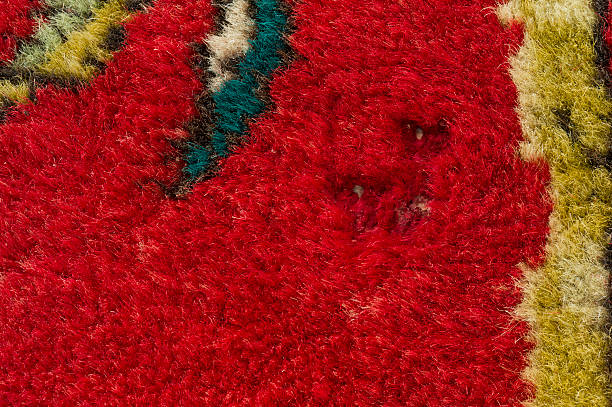Wool rugs can last for HUNDREDS OF YEARS. A carpet is considered “antique” in our industry only if woven before 1900. Many of these rugs are built to last and do so when they are properly maintained.
If you place a rug under the wrong conditions with nasty bugs, you could lose it in less than a year. Moths, carpet bugs, and other bugs that feed on contaminants in the rug fibers can eat away at it.
The 8’x10″ Turkish rug completely deteriorated while stored for several years. Carpets MUST be cleaned and treated with protection before being stored. This once beautiful rug is covered in worms and waste.
The storage area is where the most damage happens. It makes sense because bugs prefer dark, undisturbed places to feed.
This bug damage is found under large pieces of furniture in homes with rugs. Moths, carpet beetles, and other insects love to eat underneath a sofa. Wear will also be found UNDERNEATH a carpet, on the reverse side.
This video shows what damage looks like and where you should look.
Damage on the top can be pretty easy to detect
The damage where the worms and bugs are no longer visible (due to cleaning or treatment) will leave behind bald patches where the wool is completely eaten away, and only the cotton foundation fibers remain.
The damage is visible on the reverse side as bare white areas, with the foundation showing through.
You will see the moth casings before the larvae hatch and starts to eat. The cases can look like webbing and “sticky links,” depending on the bug type.
Silverfish, termites, and other creepy crawlies, which are not known to eat wool, can also eat it if they see something on the fibers. Wool is only a “holder” for their meal, which they eat. Removing spills as soon as possible is important to prevent the residue from soaking into the cotton fibers.
Clean rugs are not as appealing to insects
The industry recommends cleaning rugs every one to three years, depending on the quality and frequency of vacuuming and the amount of use the rug receives (feet, paws, etc.).
Our rug shop reminds clients to wash their area rugs every two years if the rug is marked as “active.” We remind owners sooner if their pets have been in accidents several times. Moths, for some reason unknown, love wool fibers soaked with urine. These areas will be the first to be eaten.
A quick cleanup of pet accidents can help reduce this risk. It is also possible to clean more efficiently by applying a fiber protectant to the wool fibers. This helps “suspend the urine” for longer. The rug is not protected, but the fiber protector can help to lessen damage and improve the cleaning process.
(By the way, pet urine can cause severe dye and fiber damage on your rug over time. If you have not done a quick cleanup, you should plan to wash your rug soon. A combination of moths and pet urine will cause a rug catastrophe if this happens. These bugs usually consume the rug on the backside, so inspect there.
UC Davis has published a study about preventing bugs from entering your home by caring for rugs, wall-to-wall, and carpeting.
You can find their information on carpet beetle control here: UC DAVIS – Carpet Beetles.
Here is their webpage on Cloth Moth Management: UC DAVIS – Cloth Moths
Both emphasize the importance of vacuuming and cleaning regularly to help prevent an infestation.
How do you vacuum wool rugs
You should have a routine to maintain your wool or silk investment rugs in good condition. This will ensure that they last for many generations to come.
If you have rugs stored away, plan to remove them and take care of them immediately. If you don’t store them immediately after washing, plan to remove them from storage as soon as possible. Incorrect storage is the most common cause of rug damage. It is heartbreaking to lose rugs because people store them in storage for protection, but they often lose them.
The moths in a storage unit destroyed several rugs belonging to the client. These included Navajo rugs and South American rugs. Moths are more likely to damage tribal rugs. The rugs were also wrapped up in plastic, which caused mildew. Wool rugs must NEVER be wrapped with plastic.
After watching the videos and inspecting your rug, if you find any bugs, you should first call your pest control specialist, who will treat your rug (and kill any bugs). Your rug specialist will then be contacted to wash your rug and advise you about other treatments the rug might need in the future.
Vacuuming and washing rugs regularly is the best way to protect them from bugs that can cause damage. The more you vacuum, the longer it will take to wash your rug.

